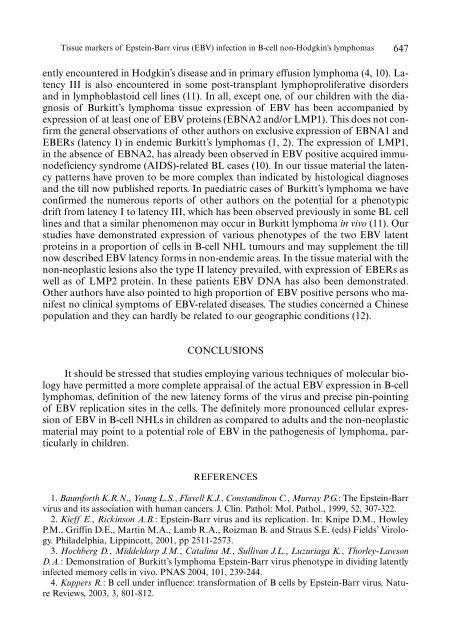Medycyna Wieku Rozwojowego
Medycyna Wieku Rozwojowego
Medycyna Wieku Rozwojowego
You also want an ePaper? Increase the reach of your titles
YUMPU automatically turns print PDFs into web optimized ePapers that Google loves.
Tissue markers of Epstein-Barr virus (EBV) infection in B-cell non-Hodgkin’s lymphomas<br />
ently encountered in Hodgkin’s disease and in primary effusion lymphoma (4, 10). Latency<br />
III is also encountered in some post-transplant lymphoproliferative disorders<br />
and in lymphoblastoid cell lines (11). In all, except one, of our children with the diagnosis<br />
of Burkitt’s lymphoma tissue expression of EBV has been accompanied by<br />
expression of at least one of EBV proteins (EBNA2 and/or LMP1). This does not confirm<br />
the general observations of other authors on exclusive expression of EBNA1 and<br />
EBERs (latency I) in endemic Burkitt’s lymphomas (1, 2). The expression of LMP1,<br />
in the absence of EBNA2, has already been observed in EBV positive acquired immunodeficiency<br />
syndrome (AIDS)-related BL cases (10). In our tissue material the latency<br />
patterns have proven to be more complex than indicated by histological diagnoses<br />
and the till now published reports. In paediatric cases of Burkitt’s lymphoma we have<br />
confirmed the numerous reports of other authors on the potential for a phenotypic<br />
drift from latency I to latency III, which has been observed previously in some BL cell<br />
lines and that a similar phenomenon may occur in Burkitt lymphoma in vivo (11). Our<br />
studies have demonstrated expression of various phenotypes of the two EBV latent<br />
proteins in a proportion of cells in B-cell NHL tumours and may supplement the till<br />
now described EBV latency forms in non-endemic areas. In the tissue material with the<br />
non-neoplastic lesions also the type II latency prevailed, with expression of EBERs as<br />
well as of LMP2 protein. In these patients EBV DNA has also been demonstrated.<br />
Other authors have also pointed to high proportion of EBV positive persons who manifest<br />
no clinical symptoms of EBV-related diseases. The studies concerned a Chinese<br />
population and they can hardly be related to our geographic conditions (12).<br />
CONCLUSIONS<br />
It should be stressed that studies employing various techniques of molecular biology<br />
have permitted a more complete appraisal of the actual EBV expression in B-cell<br />
lymphomas, definition of the new latency forms of the virus and precise pin-pointing<br />
of EBV replication sites in the cells. The definitely more pronounced cellular expression<br />
of EBV in B-cell NHLs in children as compared to adults and the non-neoplastic<br />
material may point to a potential role of EBV in the pathogenesis of lymphoma, particularly<br />
in children.<br />
REFERENCES<br />
1. Baumforth K.R.N., Young L.S., Flavell K.J., Constandinou C., Murray P.G.: The Epstein-Barr<br />
virus and its association with human cancers. J. Clin. Pathol: Mol. Pathol., 1999, 52, 307-322.<br />
2. Kieff E., Rickinson A.B.: Epstein-Barr virus and its replication. In: Knipe D.M., Howley<br />
P.M., Griffin D.E., Martin M.A., Lamb R.A., Roizman B. and Straus S.E. (eds) Fields’ Virology.<br />
Philadelphia, Lippincott, 2001, pp 2511-2573.<br />
3. Hochberg D., Middeldorp J.M., Catalina M., Sullivan J.L., Luzuriaga K., Thorley-Lawson<br />
D.A.: Demonstration of Burkitt’s lymphoma Epstein-Barr virus phenotype in dividing latently<br />
infected memory cells in vivo. PNAS 2004, 101, 239-244.<br />
4. Kuppers R.: B cell under influence: transformation of B cells by Epstein-Barr virus. Nature<br />
Reviews, 2003, 3, 801-812.<br />
647



